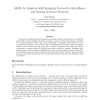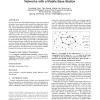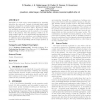98
Voted
ESOA
2006
15 years 3 months ago
2006
We present a simple model of self-organization for sensor networks that addresses two conflicting requirements: hazard situations should be reported to a sink node with as little ...
94
Voted
MDM
2005
Springer
15 years 5 months ago
2005
Springer
Sensor networks are promising unprecedented levels of access to information about the physical world, in real time. Many areas of human activity are starting to see the benefits ...
114
click to vote
MOBIHOC
2004
ACM
15 years 11 months ago
2004
ACM
Clock synchronization is a crucial basic service in typical sensor networks, since the observations of distributed sensors more often than not need to be ordered ("a happened...
100
click to vote
MOBIHOC
2005
ACM
15 years 11 months ago
2005
ACM
In this paper, we investigate the use of limited infrastructure, in the form of wires, for improving the energy efficiency of a wireless sensor network. We call such a sensor netw...
107
Voted
MOBIHOC
2008
ACM
15 years 11 months ago
2008
ACM
Recent research shows that significant energy saving can be achieved in wireless sensor networks with a mobile base station that collects data from sensor nodes via short-range co...
181
Voted
SIGMOD
2007
ACM
16 years 10 days ago
2007
ACM
SwissQM is a novel sensor network platform for acquiring data from the real world. Instead of statically hand-crafted programs, SwissQM is a virtual machine capable of executing b...
172
Voted
SIGMOD
2007
ACM
16 years 10 days ago
2007
ACM
Sensor networks are widely used in many applications for collecting information from the physical environment. In these applications, it is usually necessary to track the relation...
203
click to vote
GIS
2008
ACM
16 years 1 months ago
2008
ACM
By embedding sensors in mobile devices, it is possible to exploit the ubiquitous presence of these devices to construct applications for large-scale sensing and monitoring of envi...




